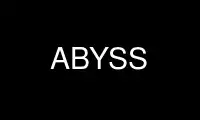
This is the command ABYSS that can be run in the OnWorks free hosting provider using one of our multiple free online workstations such as Ubuntu Online, Fedora Online, Windows online emulator or MAC OS online emulator
PROGRAM:
NAME
ABYSS - assemble short reads into contigs
SYNOPSIS
ABYSS [OPTION]... FILE...
DESCRIPTION
Assemble all input files, FILE, which may be in FASTA, FASTQ, qseq, export, SRA, SAM or
BAM format and may be compressed with gz, bz2 or xz and may be tarred.
Users wishing to run a full assembly with ABySS are recommended to use abyss-pe as their
entry point rather than the ABYSS program. abyss-pe is a Makefile that coordinates many
of the ABySS tools (including ABYSS) in order to run the full ABySS assembly pipeline.
abyss-pe is capable of doing many things that ABYSS is not, such as leveraging the
distance information provided by paired end reads and mate pair reads.
--chastity
discard unchaste reads [default]
--no-chastity
do not discard unchaste reads
--trim-masked
trim masked bases from the ends of reads [default]
--no-trim-masked
do not trim masked bases from the ends of reads
-q, --trim-quality=THRESHOLD
trim bases from the ends of reads whose quality is less than the threshold
-Q, --mask-quality=THRESHOLD
mask all bases in reads whose quality is less than the threshold
--standard-quality
zero quality is `!' (33)
default for FASTQ and SAM files
--illumina-quality
zero quality is `@' (64)
default for qseq and export files
-o, --out=FILE
write the contigs to FILE
-k, --kmer=KMER_SIZE
k-mer size
-t, --trim-length=TRIM_LENGTH
maximum length of dangling edges to trim
-c, --coverage=COVERAGE
remove contigs with mean k-mer coverage less than this threshold
-b, --bubbles=N
pop bubbles shorter than N bp (default: 3*k).
-b0, --no-bubbles
do not pop bubbles
-e, --erode=COVERAGE
erode bases at the ends of blunt contigs with coverage less than this threshold
-E, --erode-strand=COVERAGE
erode bases at the ends of blunt contigs with coverage less than this threshold on
either strand
--coverage-hist=FILE
record the k-mer coverage histogram in FILE
-g, --graph=FILE
generate a graph in dot format
-s, --snp=FILE
record popped bubbles in FILE
-v, --verbose
display verbose output
--help display this help and exit
--version
output version information and exit
Use ABYSS online using onworks.net services
